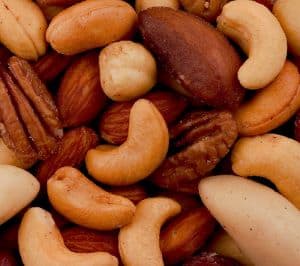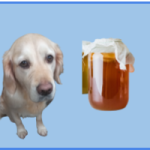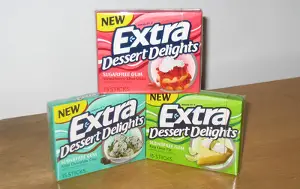There can be a lot of different nuts in a container of mixed nuts, depending on the brand.
Peanuts, which are actually a legume, are often included. Walnuts, Brazil nuts, cashews, almonds, hazelnuts and pecans are the usual constituents.
These nuts can be raw, roasted/salted or honey roasted, depending on what’s in them.
A few of them may also be honey roasted, which adds a whole new dimension to the question about whether or not it’s a serious problem should a dog get into them.
Raw nuts rarely contain peanuts, as they aren’t good to eat raw.
Are any of these nuts toxic for dogs?
Pecans and black walnuts are toxic to dogs.
However, black walnuts are not generally in mixed nuts.
You should check the ingredients carefully, making sure that it says English walnuts, as they are not toxic.
Should there be macadamia nuts in the mixed nut container, those are also toxic to dogs.
What are the common side effects of a dog eating too many mixed nuts?
The side effects depend on the nut blend, any additives and the amount given per body weight. If you skip the toxic nuts and there are no additives, there still can be problems.
Pancreatitis is a condition that can be extremely mild or life threatening. It depends on the severity of the attack.
If it happens often enough it could become a chronic condition, requiring treatment on a regular basis. The fat content of the nuts are the main culprit.
No matter the additives, the fat content can lead to an overweight dog.
Obesity causes all kinds of problems, including joint issues, mobility problems and chronic illnesses such as diabetes. The pancreatitis issue may also lead to diabetes in some dogs.
Additives to mixed nuts can include salt, coco powder, sugar and just about anything else.
If it is a trail mix sort of mixed nuts, it may even have raisins. None of these additives are good for dogs and two are downright poisonous.
Too much salt can give a dog high blood pressure.
This is just as deadly for dogs as it is for humans, causing kidney disease, heart disease and other problems.
Even sea salt is too much for dogs, though marginally better for humans.
Raisins and grapes can kill your dog quickly.
For a small dog, it only takes eight before it becomes a veterinary emergency. At best, that’s expensive and at worst it will kill.
Never give a dog grapes, raisins or any grape containing product.
Chocolate and coco are also toxic to dogs.
A vet tech friend often tells stories of dogs brought in who got into chocolate, particularly at Christmas and Easter when a lot of it is around and within a dog’s reach.
Theobromine is the toxic property and it, too, can kill your dog.
How else might mixed nuts be dangerous for a dog?
Nuts have a tendency to be on the small side.
They constitute a choking hazard, particularly for small dogs. If the dog aspirates the nut, it could mean a trip to the vet and an emergency endoscopy to get it out of the lungs.
How nutritious are nuts?
The occasional nutty treat does have some nutritional benefit for your dog. Each of the nuts has a slightly different nutrition profile.
Those listed below are raw and unsalted, as they have the most nutrition with the least detriment.
Almonds:
A one ounce serving of almonds has five hundred seventy nine calories, twenty one point two grams of protein and twenty one point six grams of carbs.
Of the carbs, four point four are from sugars. They also contain calcium, iron and potassium. Several other nutrients have trace amounts.
Brazil nuts:
An ounce of Brazil nuts is between six and eight nuts.
That has one hundred eighty seven calories, nineteen grams of fat and three point three grams of carbs.
One thing to watch for in dogs that are given Brazil nuts is the selenium content. An ounce gives humans one thousand percent of the RDA of the mineral.
That can be too much for some dogs.
Other vitamins and minerals found in these nuts include calcium, magnesium, phosphorus, potassium, zinc and Vitamin E.
None of these are in amounts that could present problems. It might be wise to avoid Brazil nuts for small dogs.
Cashews:
Raw cashews have an impressive array of nutrients.
One hundred fifty five calories per ounce with twelve point three grams of fat are in the nuts.
Vitamins C, various B vitamins and vitamin E are found in the nuts as is potassium, calcium, iron, magnesium, phosphorus, zinc, copper and selenium.
Walnuts:
Fourteen English walnut halves contain one hundred eighty five calories and four point three grams of protein.
Eighteen point five grams of fat are in the calorie count.
Walnuts also have copper, folic acid, phosphorus, B6, manganese and vitamin E.
Are there safer and cheaper treats for dogs to eat?
Nuts have a lot of nutrition, but they can be dangerous to dogs, due to the choking hazard and the risks of pancreatitis. Many other human foods can make a cheaper and safer alternative.
Dogs can eat many of the fruits and vegetables we eat, and they do enjoy some of them. They can also eat eggs, most meats, bread and crackers.
There are occasions when doggy treats come in handy, especially in the desert Southwest.
Rather than give a dog human ice cream, there are dog versions available.
What other foods have similar nutrients?
Legumes can be a good choice in place of nuts.
With a few exceptions, dogs can eat the same beans that humans can.
Never feed a dog fava beans, raw kidney beans or coffee beans (technically not a bean, but…). Also, there is far too much fat in canned beans.
Chili beans, baked beans and refried beans are also off the menu.
For the oils found in beans, canola oil and olive oil are good alternatives.
Plainly cooked chickpeas are also good, although hummus might not be a good idea if there are a lot of additives, including salt.
How dangerous are salted mixed nuts?
The extremity of danger is in part the size of the dog.
A small dog would be in a lot of danger with just a few salted nuts. A larger dog might get away with it on occasion.
As with humans, salt can raise blood pressure, damage the kidneys and do all kinds of other things.
So, my dog ate mixed nuts, is it ok?
If your dog accidentally got into a bag of mixed nuts, check to see what’s in them.
If there are pecans or macadamia nuts, then the dog may need a visit to the vet. If it’s a small dog and there were Brazil nuts in the mix, ditto.
Most nuts, in small amounts and given occasionally, are healthy and nutritious for dogs.
In fact, nut butters are often used to give medications to dogs… especially when pill pockets don’t work. It is important to make sure that there are no additives.
Raw, unsalted nuts are far better for both the human and the pet.
These seldom have anything other than the nuts themselves in them.
That relieves the worry about too much salt as well as the addition of sugar or extra oils.
Mixed nuts in trail mixes should be carefully watched.
Most trail mixes have things such as raisins in them, which are toxic to dogs. They may also contain chocolate, which is also toxic.
If your dog gets into trail mixed nuts, talk to your vet as soon as possible.
Nut additives such as honey roasted, chili or salt are not good for your dog.
Too much sugar can cause pancreatitis.
The addition of chili can cause digestive problems and will likely make your dog very uncomfortable.
As the digestive issue usually happens in the dark of night, it will also make you unhappy if it’s an indoor dog that “goes” outside.
Added salt is as bad for dogs as it is for humans.
This is especially true of small dogs and older dogs that may already have health issues. They should not be used as treats very often… if at all.
Other human foods make better snack alternatives for dogs.
In our family, corn and beans have always been a favorite for our dogs. Some even enjoyed the occasional carrot or piece of raw broccoli.
Always check with your vet before adding something to your dog’s diet, even treats.
That will help you know what is best for your particular dog.
The vet will know of any health issues the pet may have and can take the dog’s breed and size into account to give you appropriate amounts.
Resources






